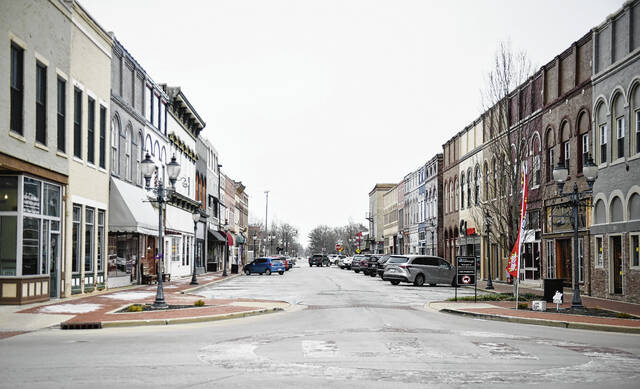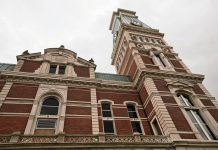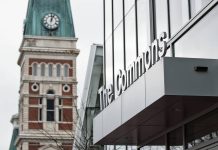
The Victorian-era buildings in Edinburgh’s historic downtown district. The town is celebrating its bicentennial with a year-long slate of activities and events recognizing its storied past.
RYAN TRARES | DAILY JOURNAL
By Ryan Trares | Daily Journal
EDINBURGH — The tidbits accumulated over 200 years of history have bubbled up all over Edinburgh.
As local residents prepared for the town’s bicentennial this year, they discovered an amazing amount of wild, wonderful facts that had otherwise been lost to time.
Edinburgh High School was one of the first 30 schools to be commissioned in the state.
Lind Drive, a stretch of road on the east side of town, was named in honor Lt. Louis Grant Lind, a World War II U.S. Air Force fighter pilot who was killed in action over Italy.
The town is the final resting place of Red Cloud, a world record-holding trotting horse who took the country by storm in the 1870s.
“It’s remembering things about our town that we may have forgotten,” said Cathy Hamm, a member of the Edinburgh Bicentennial Committee. “Many of us know different things that have gone on in the community, and the notable ones that people talk about that may have happened way before some of us were born. But this is bringing to light so much of our heritage.”
Excitement is percolating through the Edinburgh community as it gears up for its bicentennial celebration. Local residents and town officials have been working on the festivities for the past four years, planning activities, lining up sponsors and digging through two centuries of history.
Organizers have envisioned a gala dinner, a weekend-long festival and a parade to rival any other the town has put on. Activities will be worked into existing Edinburgh events throughout the year.
This year is a momentous occasion for the town, not only to look back to the past, but to unite Edinburgh in the present and plan for the future, said SaraBeth Drybread, director of the John C. Drybread Community Center in Edinburgh and part of the bicentennial committee.
“The more that you read the history of a community, the more pride you have in it — to really understand the vision that so many of these early founders OVERSET FOLLOWS:had and literally built this town from the ground up,” Drybread said. “It makes me think about the next 200 years, and what we’re doing now to leave behind for future generations.”
The Edinburgh area was first settled in the early 1820s by John Campbell, with the original plat containing 32 lots in 1822. Throughout its history, it became a thriving town, boosted by railroads and mills and the establishment of the veneer industry, for which Edinburgh is still famous.
Log cabins became ornate mansions and Victorian buildings. Arts and culture flourished.
For the bicentennial, organizers wanted to weave all of those stories, and more, together. Planning for this year started in 2018, as Drybread and a dedicated team of volunteers met to discuss what should be included.
“The basic brainstorming was, what is it about our community that we really want to highlight and celebrate during that year,” Drybread said.
For years now, Edinburgh residents have spent hours pouring over archived documents, old newspapers and files of writings in search of unique pieces of history.
They discovered that the first store in Johnson County opened in the town in 1822. Merchants Booth and Newby of Salem opened a general store and sold the first goods in the county. A group called the Edinburgh Benevolent Society met in 1833 to plan and build the first religious meeting house.
In their searches, bicentennial organizers stumbled across an address presented to town residents on July 4, 1876. The United States was celebrating its own centennial, and Edinburgh officials took the opportunity to recognize its own 54-year-old history as well.
The author, J.H. Clarke, outlined the genesis of the town, from the exploits of French explorers to the arrival of frontiersmen to the area to hardship and resolve of the first settlers.
“There were things that many of us had never heard of before,” Drybread said. “There was information about the early settlers, and where they came from and the hardships they went through. It was written very poetically, and you really get a feel and picture for what life was like for these families who came in the 1820s to settle.”
But what truly resonated in the doctrine was the final lines:
”Men of high resolve and unbending courage; untiring zeal and unconquered spirits; men with nerves of steel and sinews of iron! The pioneers of Blue River Valley, who in the contest with nature never faltered or gave up the batter and let their names be handed down the ages as mighty men of renown,” Clarke wrote.
The prescient and moving document has become the kick-off of the town’s bicentennial events and activities. On March 3, a group of residents are going to read portions of the address while filling in some of the history of Edinburgh.
That reading leads into a fundraising dinner on March 4 — the day Edinburgh was settled in 1822. Organizers have planned a pork loin dinner with roasted vegetables and a caramel popcorn-themed dessert at the Edinburgh Pixy Theatre, adjacent to downtown.
The celebration moves quickly from there. A historic church tour featuring four of Edinburgh’s longtime congregations — Holy Trinity Catholic Church, Edinburgh United Methodist Church, Edinburgh Presbyterian Church and Edinburgh Christian Congregation — will open up their buildings to show off the unique architecture and contributions to town.
Walking tours of the historic districts in the town are also planned.
All of it leads to the Bicentennial Birthday Bash, scheduled for June 10 and 11.
People will gather on what’s known as “School Hill” on the west side of downtown for hot air balloon rides, pony rides, a magician, food trucks, local vendors, six different bands and fireworks. People will compete in historic games, such as pie-plate walk and rolling pin throw.
“We’re going to bring back some of these weird games, and have some new games as well,” Drybread said.
On the first day of the festival, Edinburgh will celebrate its diverse industry, past and present.
“Veneer is our bread and butter. That’s what we’re known for,” Drybread said. “But the more we started talking about it, we realized that people aren’t always certain what a lot of the industries that we have here do. So we’ve asked those companies to come out and have a booth, bring a prototype … and talk to the community about what they create.”
Organizers also pushed to have a presence at some of Edinburgh’s other well-known events, such as the annual Fall Festival. They’ll have floats in the parade and a booth at the different events.
Prior to the parade is a new running race — the Red Cloud Trot 5K, named for the record-holding trotting horse.
Planners have also worked with the family of longtime Edinburgh historian Sarah Otto, who wrote “The History of Edinburgh 1820-1986,” to reprint the book with an addendum updating the town’s history to the present.
“We’ve been looking through old phone books, going through old (Edinburgh) Couriers, finding all of the resources, recalling so much of days gone by,” said Hamm, who has been focused on this project. “It’s a fantastic opportunity for our whole community to relive what has happened over the years.”
No celebration would be complete without swag to commemorate the special year, and officials are planning to have t-shirts and hats and other items to help people remember the bicentennial.
Drybread has even worked with Middle Davids Artisan Candles in Franklin to create two Edinburgh-themed scents: a caramel popcorn candle, in reference to the town’s famed Not Just Popcorn business, and one that smells of a lumberyard, a nod to the veneer industry.
The project has been exciting to put together, and enthusiasm is building across the community. A buzz is palpable among local residents, and that’s only expected to grow as the year goes on, she said.
“You realize in this milestone year just how much of a family a small community is. As we get all of these facts online, people are commenting on things they remember, and their own stories,” Drybread said. “It’s been very inspirational. Edinburgh is a very unique community. We’re so self-sufficient, and for a small community, to be able to offer what we do, it’s really incredible.”




